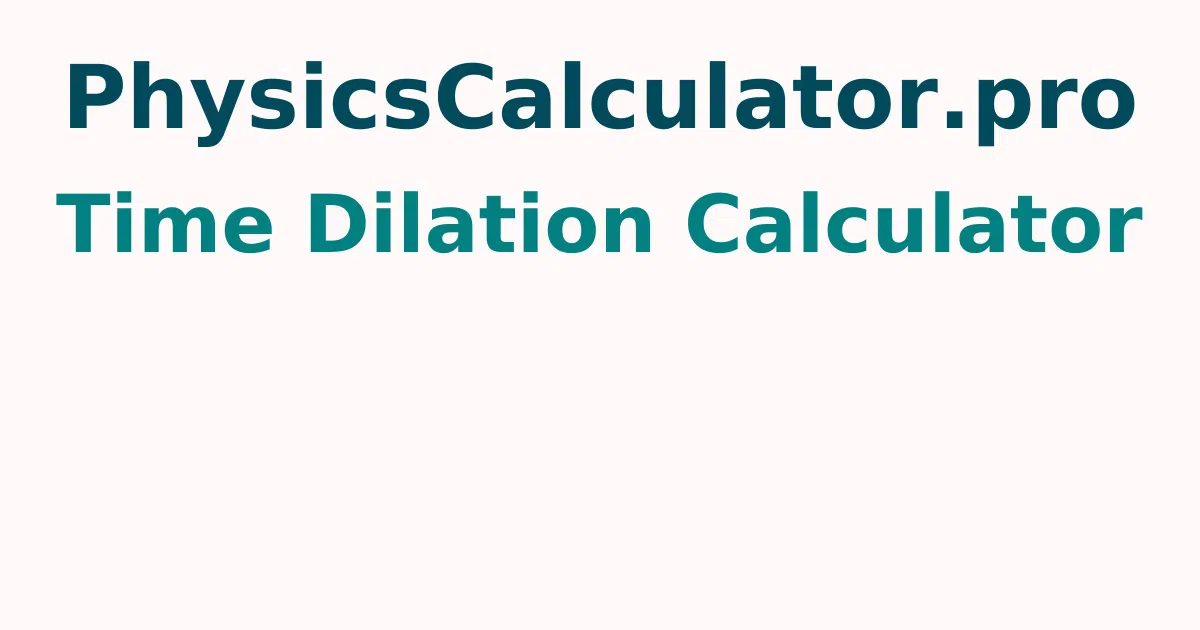Time Dilation Calculator
The Time Dilation Calculator can calculate the time dilation of a body travelling at a certain relative velocity with regard to the observer during a given period of time.
Time Relativity
The time dilation concept asserts that everyone perceives time differently. When you travel at a rapid rate, time starts to slow down. Obviously, you don't get to move in slow motion; it all happens in the blink of an eye. Instead, you'll see that any objects you move relative to pass time far more slowly.
What is meant by Time Dilation and its Formula?
The dilation of time is a result of Einstein's special relativity theory, which states that the perception of time flow varies depending on the relative speed of movement of an object relative to an observer.
The Lorentz factor is used in the calculation, which is done using the following formula:
Δt'= γΔt=Δt/√(1–v2/c2)
- where, Δt' denotes the passing of time as measured by a traveling observer (relative time)
- Δt denotes the passing of time as measured by a stationary observer
- v is the speed of the traveling observer
- c is the speed of light and its value is (299,792,458 m/s)
- γ is the Lorentz factor
How to use the Time Dilation Calculator
The following are the steps to utilising this time dilation calculator for the speed of light:
- Enter the Time Interval value first, then select the unit from the drop-down option.
- For calculate the Observer Velocity, enter a value and select a unit from the drop-down selection.
- The calculator will automatically calculate the Relative Time value when you enter both numbers.
You can checkout more concept with physicscalculatorpro.com to get quick answers by using this free tool.
Time Dilation Equation Examples
Question 1: Calculate the relative time of moving object with the velocity at 45 m/s and the time interval is 50s.
Solution:
Consider the problem, we have
Time interval (Δt) = 50 sec
Observer velocity (v) = 45 m/s
c is the speed of light and its value is (299,792,458 m/s)
The formula for finding the relative time of moving objectΔt' = γΔt = Δt/√(1–v2/c2)
Δt' = 50/√(1-(45)2/(299,792,458)2)
Relative time = 50.0 sec
Therefore,the relative time of moving object is 50.0 sec
FAQs on Time Dilation Calculator
1. What is time dilation and its formula?
The dilation of time is a result of Einstein's special relativity theory, which states that the perception of time flow varies depending on the relative speed of movement of an object relative to an observer. The Lorentz factor is used in the calculation, which is done using the following formula: Δt' = γΔt = Δt / √(1 – v2/c2)
2. State time dilation principle?
The time dilation principle states that everyone perceives time differently. When you travel at a rapid rate, time starts to slow down. Obviously, you don't get to move in slow motion; it all happens in the blink of an eye. Instead, you'll see that any objects you move relative to pass time far more slowly.
3. How much slower is time in space than it is on Earth?
Time might flow slower or quicker for you in respect to other persons in another section of time-space depending on your speed and position. For example, personnel aboard the International Space Station age more slowly than those on Earth.
4. What causes the time dilation to slow down?
Time dilation is a fairly simple phenomenon that can only occur if everyone in the same medium has the same speed of light. With respect to an object approaching the speed of light, the pace of time experienced by an observer may alter. As a result, two events in the space-time continuum with different time beginnings in relation to each other will never overlap.
5. How have atomic clocks been used to prove time dilation?
Time is defined in each frame of reference, according to Albert Einstein's theory of relativity. By connecting a clock with each referential, we can calculate the time changes (time dilation) for an observer outside the clock frame of reference, who will view a clock moving a tick slower than a stationary clock. Placing atomic clocks in planes and comparing the time of the clocks after returning to earth resulted in a shift close to that predicted by the hypothesis.
